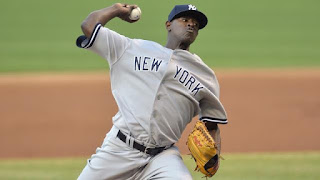Exploring the idea of Chad Green as a starter in 2018
Chad
Green made quite a name for himself out of the Yankee bullpen in 2017. The
26-year-old righty finished the season with a perfect 5-0 record to go along
with a dazzling 1.83 ERA, 0.74 WHIP, 1.75 FIP, and 13.4 K/9 rate. In 69
innings, Green picked up 103 strikeouts, walking just 17 and he only allowed 34
hits, holding hitters to a .147 batting average against. With his dominance,
Green became one of the most trusted relievers in the Yankee bullpen. Despite
that, Brian Cashman and Green made headlines yesterday when Cashman told MLB.com's Bryan Hoch that
Green would enter 2018 as a starting pitcher, with pitching out of the bullpen
as the fallback option.
The
Yankees used Green primarily as a starter in his rookie season, with eight of
his 12 appearances being in the Yankee rotation. However, Green pitched much
better out of the bullpen in 2016 with a 0.00 ERA and 0.96 WHIP in 9.1 innings,
compared to a 5.94 ERA and 1.51 WHIP in 36.1 innings as a starter. In 2017, the
Yankees used Green as a spot starter for just one of his 40 appearances, and he
lasted just two innings, allowing two runs on two hits. Granted, Green had
pitched 3.1 innings the day before that start.
While Green has some glaring concerns regarding his history as a starter, let’s not forget that people were saying the same thing about Luis Severino following his disastrous 2016 season. As a starter in 2016, Severino went 0-8 with a disgusting 8.50 ERA and 1.78 WHIP in 11 starts, where he allowed an opponent’s batting average of .337. Inversely as a reliever, Severino was 3-0 with a 0.39 ERA in 11 outings, with a 0.77 WHIP and .105 BAA. Many were calling for Severino to stay in the bullpen, but he keyed in on correcting many mistakes he made in 2016, including keeping the ball tight to his body when he was winding up. In 2017, Severino dominated going 14-6 with a 2.98 ERA, 1.04 WHIP and .208 BAA, throwing the “failed starter” narrative out the window.
As
a three-pitch pitcher, Severino really developed his changeup as a strong third
pitch, and he also increased the effectiveness of his slider, which has a
tendency to spin in the middle of the zone as a starter. Severino relied
heavily on his fastball in 2016 where he threw it 56.20% of the time, compared
to 34.11% for his slider and just 9.69% for the changeup. In 2017, Severino
threw his fastball 51.70% of the time, his slider 34.97%, and changeups
accounted for 13.33% of the pitches he threw. He also saw his average fastball velocity
jump from 96.89 MPH in 2016 to 97.76 MPH in 2017.
Point
being, Severino worked this offseason so that he could win a spot in the
rotation, and he thrived all season, which will likely result in a top-three Cy
Young finish in the American League. As
for what all this has to do with Chad Green, Green has the potential to be a
similar pitcher as Severino. Sure, they both have different pitch arsenals, but
they are right-handers who throw hard and have previously had much success out
of the bullpen.
For
Green to be successful as a starter, he is really going to have to develop a
third pitch. Having a strong third pitch is frequently the difference between a
pitcher being destined for the rotation, or being relegated to the bullpen.
Green’s best pitch is his fastball, which averaged a velocity of 96.07 MPH, up
from his average of 95.40 MPH in 2016. From there, his out pitch was the
slider, which he threw 22.89% of the time. As a reliever, he was able to get
away from his cutter, which averaged about 90 MPH, but he only threw 6.5% of
the time, compared to 15.07% of the time as a starter in 2016. He also mixed in a sinker and a splitter, but very rarely, with each
pitch being around or below 1% of his pitches in 2017.
Essentially,
the key for every successful starter is a fastball that hitters struggle to
touch, and solid secondary pitches. In 2016, opposing hitters hit .295 off his fastball,
but Green obviously worked hard to correct that this season, and he held
hitters to a .121 average off that pitch this year. He also held batters to a
mere .200 average off his slider, and a .235 clip against the cutter.
Severino
really relied on the guidance of Hall of Famer Pedro Martinez for his newfound
success this year, and Green needs to use that as a motivating factor in
becoming a successful starter in a rotation that could be very strong next
season with a three-headed monster of Sevy, Masahiro Tanaka, and Sonny Gray.
And the reality is, Green should not be pressured to be as dominant as he was
as a reliever. With this potential rotation in place, Green will be a back-end
starter or even an opener, so if he can correct some of his issues he’s faced previously as a
starter, he could solidify a forceful New York Yankee rotation in 2018, even if
it comes at the expense of losing a dominant bullpen arm. The Yankees should be
just fine there with David Robertson, Tommy Kahnle, Dellin Betances, and
Aroldis Chapman under contract for 2018, so Green should accept the challenge
of coming into camp as a starter with open arms. If it works out, the Yankee
pitching staff could lead them to a division title next year.
Article by: Chad Raines
Follow @chad_rainFollow @BronxBomberBall




Comments
Post a Comment